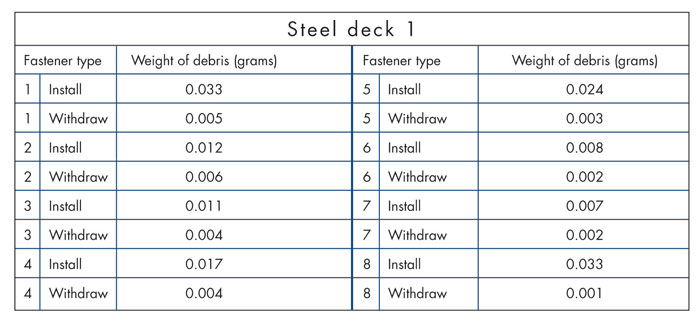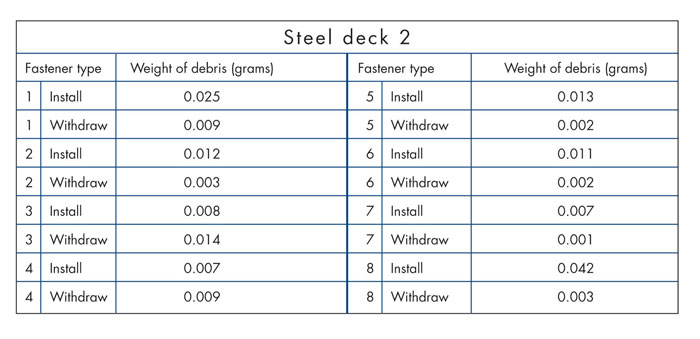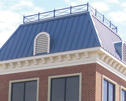Building codes require a roof assembly to sufficiently resist uplift forces caused by wind events that may occur during the roof assembly's anticipated life. Mechanically attaching roof insulation and roof membranes is one method that provides enough uplift resistance to hold a roof system in place.
Using self-tapping screws to attach roof insulation and roof membranes to steel roof decks has become a common attachment method. However, problems can arise because of debris generated when screws are replaced during reroofing projects. Our company conducted a test using various screw types and sizes to examine the quantities of debris produced by different screws and address how debris can affect a building's interior, as well as whether screw debris poses potential problems for facilities that manufacture such items as food or electronics.
Background
Before mechanical attachment, insulation commonly was secured to steel roof decks using hot asphalt. However, the hot asphalt method has flaws; when an interior fire occurs below a steel deck, the hot steel melts the asphalt, which drips through weld holes or laps in the deck and onto the fire below. The dripping asphalt acts as an accelerant, spreading the interior fire.
On Aug. 12, 1953, the uncontrolled spread of fire through most of a 1.5 million-square-foot General Motors plant in Livonia, Mich., was attributed mainly to asphalt dripping through the building's steel roof deck. As a result, the insurance and roofing industries began to explore other insulation attachment methods.
The first mechanical attachment methods were used with hot asphalt adhesives. This involved driving a semicircular steel fastener with clips through a metal deck with a rubber mallet. The clips, or "fish hook" extensions, along the sides of a fastener would engage the metal deck, securing the insulation. A second method involved a serrated steel shank fastener that had limited attachment to a metal deck. These methods resulted in many roof systems failing during wind events.
Eventually, self-tapping screws with plates became the industry norm for attaching roof insulation to steel decks, eliminating the need for asphalt between the bottom of roof insulation and top of a steel deck. Uplift testing performed by testing laboratories such as FM Global and Underwriters Laboratories Inc. resulted in the development of frequency and pattern for mechanical attachment. The quantity and location of fasteners used varies depending on the roof insulation's type, thickness and manufacturer.
To meet building codes, the number of self-tapping fasteners installed can dramatically increase in the field and at perimeter and corner locations.
The process
The use of self-tapping screws involves penetrating a steel deck. During this process, as a screw rotates, the drilling motion creates a hole in the steel deck. Steel filings from the screw, steel deck and coating material are generated and can fall into a building's interior. The debris typically is of little concern when installing roof systems on new construction and when reroofing is performed above ceilings. However, during a reroofing project on an occupied building without a ceiling, filing and coating debris generated as existing screws are removed and new screws are installed can be problematic.
Laboratory analysis

Figure 1: Jim D. Koontz & Associates Inc., Hobbs, N.M., tested eight types and sizes of self-tapping screws commonly used for mechanical attachment.
There have been no previous tests performed regarding the quantity of debris generated when roofing components are mechanically attached to a steel deck. To examine this, our company acquired eight types and sizes of self-tapping screws commonly used to secure roof insulation to steel decks; see Figure 1.

Figure 2: Average weight of debris generated during installation and removal of self-tapping screws on steel deck 1
Using a standard electrical drill, three sets of eight self-tapping screws were driven into two 22-gauge steel decks that had been galvanized and painted. The steel decks were mounted over an enclosed box lined with a clean membrane. The filing and coating debris that fell into the enclosed box were collected separately as the screws were driven in and out of the steel decks. The screws penetrated about 3/4 of an inch through the decks; insulation was not used above the decks during the test. The debris then was weighed on an analytical balance and microscopically photographed so our company could characterize the debris that would enter a building using photographic analysis.
The average weight of the debris generated from the three self-tapping screws on each steel deck is included in Figures 2 and 3. The weight of the debris from screw installation in steel deck 1 ranged from 0.007 to 0.033 grams (g) per screw. The screws' removal from steel deck 1 produced debris weighing from 0.001 to 0.006 g. Debris from screw installation in steel deck 2 weighed from 0.007 to 0.042 g per screw. The screws' removal from steel deck 2 produced debris weighing from 0.001 to 0.014 g. A greater quantity and weight of debris were generated during self-tapping screw installation than during the screws' removal from the metal decks.

Figure 3: Average weight of debris generated during installation and removal of self-tapping screws on steel deck 2
Conclusions
The steel filing debris produced during the test contained sharp edges as documented in microscopic photographs. Although the quantities of debris may be small, any amount of debris contamination may be unacceptable depending on the contents of and activities performed within a building during a reroofing project.
As an occupied building is being reroofed, metal filing debris produced when installing self-tapping screws will fall to the building's interior. For most reroofing projects, the filing and coating debris does not present a problem, especially if there is a ceiling. However, depending on a building's interior activities, the debris can lead to contamination (by the metal or coating from the deck or screws) of manufactured products such as electronics, food and pharmaceuticals if debris protection is not provided. Even small quantities of debris in some critical manufacturing operations would be intolerable. The test results show that some debris undoubtedly will enter a building's interior during the installation and removal of self-tapping screws.
One method of avoiding debris-caused contamination is to temporarily halt manufacturing activities in areas beneath the exposed steel deck where reroofing is being performed. However, ceasing manufacturing activities will cause business interruption and, as a result, lost revenue. Suspending catch tarpaulins below a steel deck to collect debris as it falls is becoming more common as an alternative method to protect a building's interior and allow manufacturing activities to continue during reroofing.
Where no ceilings exist, failure to use some form of interior protection may lead to contamination of sensitive equipment and/or products manufactured within a building. This in turn could result in safety and health issues for manufactured products and their end users; for example, falling debris could cause sharp steel filings to contaminate a food product.
Alternative methods of attaching roof insulation and cover boards, such as using foam adhesives, could be explored. However, though many foam adhesive products provide sufficient adhesion, insurance groups and codes authorities such as FM Global have not yet approved using foam adhesives on steel decks.
Considerations
You should consider the potential ramifications of filing and coating debris generated during reroofing projects when there are no ceilings, especially because steps can be taken to prevent debris from contaminating a building's interior.
Safety is of utmost importance during roofing projects, and roofing professionals must strive to ensure work is performed as safely as possible. Be sure you notify building owners of potential debris problems before a project begins and provide them with prices for methods of protecting the building's interior during a reroofing project if it is necessary.
Jim D. Koontz, PE, RRC, is president and Gerald B. Curtis, CPRC, is a senior associate of Jim D. Koontz & Associates Inc., Hobbs, N.M.



